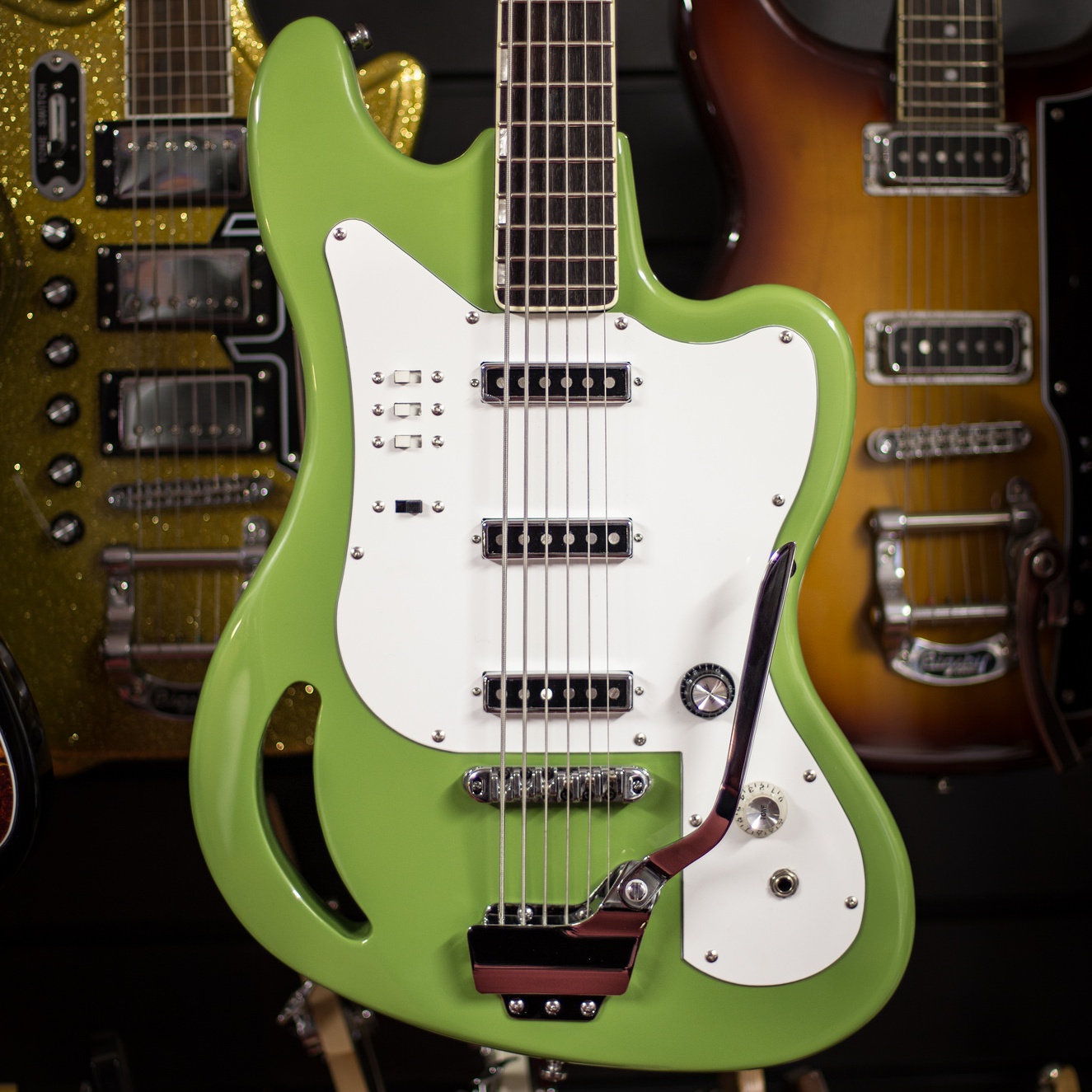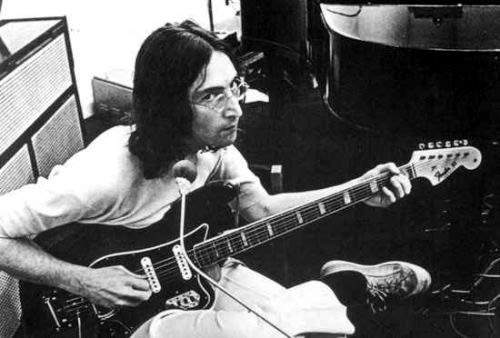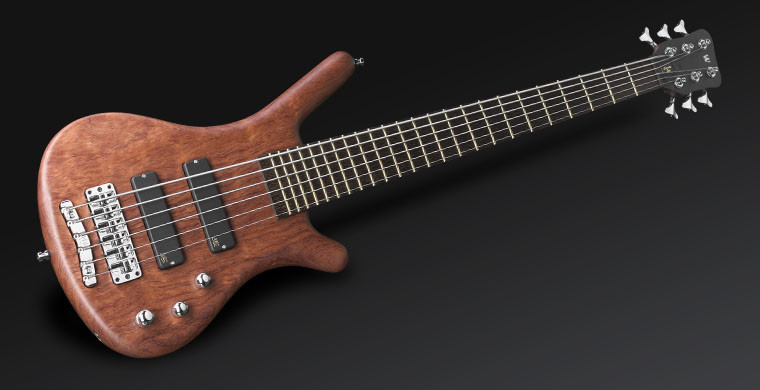
As the general wisdom goes, some musicians choose to play bass – the traditional, 4-string bass – because it’s easier than playing guitar. “If Sid Vicious could do it, then I can, too!” So… why do some players prefer 6-string basses?

John Lennon and Fender VI
The list of 6-string players include The Beatles (both John and George were pictured playing one), Peter Hook, Robert Smith of The Cure and Jack Bruce in Cream. Do you see a pattern, there? They were either guitarists, or very melodic bass players who played bass more like a lead instrument than “just” part of the rhythm section.

Peter Hook and his Shergold bass with Joy Division
4-String vs. 6-String Bass… Who Wins?
Though 4-string basses are the most commonly used by bassists of any style, there’s an argument for the benefits of owning a 6-string bass.
The 6-String bass wasn’t invented as a gimmick or to make things more complicated – in fact, it can make playing even easier!
Firstly, it’s not more difficult to play than a 4-string bass – because you can play just the same, but the two extra strings actually make it easier for the bassist to hit higher notes without moving too far down the fretboard – which some players might prefer.
Also, it’s worth considering that while a 4-string bass is tuned EADG, a 6-string bass is tuned EADGBE – just like a guitar, in other words. So, while you can still play songs the same way you’d play using a 4-string bass, because you’ll have 4 strings tuned the same, you can also play chords just like a guitar thanks to the extra two strings, which can be very interesting.
The only issue about 6-string bass is the string spacing. In some models, which have narrower necks more like a guitar, the strings are closer to each other than on your average 4-string bass, which means bassists used to a 4-string bass might sometimes find it harder to adapt. On the other hand, if you choose a 6-string as your first bass or if you started playing guitar, then you’ll no doubt feel comfortable with a six-string bass.
Watch: Cream, ‘Strange Brew’
6-String Bass vs. Baritone Guitar
It’s important not to confuse 6-string basses with Baritone guitars. Some may think they’re similar, but the results are very different – a baritone guitar can sound deeper than a normal guitar, because it’s tuned lower, but it’s still unmistakably a guitar.
Whereas a 6-string bass might look like a baritone sometimes – but it has thicker bass strings and sounds, obviously, bassier than a baritone.
Having said that – guitarists used to baritone guitars might be pleasantly surprised to find that a 6-string bass is a great alternative to use, whenever they want something “meatier”.
Watch: Eastwood TB-64 review
Eastwood TB64 Teisco Tribute
One of the hottest 6-string basses right now is, without a doubt, the Eastwood TDR-Series TB-64 bass. This model is a tribute to a very rare Teisco model, as used by Kazu Makino from New York’s Blonde Redhead.

Kazu from Blonde Redhead
Alongside the Sidejack Bass VI and the Squier/ Fender Bass VI, the TB-64 is one of the few six-string basses suitable for indie/ alternative/ classic rock – well, at least in terms of looks!
In fact, there are other types of 6-string basses by brands such as Warwick, who makes the Corvette bass. This type of 6-string bass has much wider neck to allow for bigger string spacing, like that of a regular 4-string.

Warwick 6-string bass
It’s never a great idea to generalise, but it’s probably true you won’t find many players in rock bands playing a bass like that. This kind of bass is great for jazz players and slap bass, for instance.
But whatever your style – maybe it’s time you considered a 6-string bass. After all, why limit yourself?

A distinction needs to be made here between a true six string bass and what is commonly called a Bass VI. A true six string bass is usually tuned BEADGC in addition to having a 34 inch scale length and relatively thick strings like a standard bass guitar (with the inclusion of the even thicker low B string and the thinner high C string). A Bass VI, by contrast, is tuned in standard tuning (an octave below six string guitar tuning), has a 30 inch scale length and uses string gauges that are thicker than a six string guitar but thinner than a six string bass. As noted in the article, the string spacing and neck thickness (and radius) are generally different also.
As far as the Fender Bass VI goes, a great starting pont is Peter Green who used it on extended live jams of “The Green Manalishi.
https://youtu.be/AnXhgXEoUvA
I picked up a Squier VI while ago on impulse a while ago and it’s just a gas to play. A bass with a vibrato? How can you beat that?
I actually have a great time with it just sitting in front of the TV improvising my own bits of the soundtrack – a bit of bass here, some guitar there – it does it all!
Have a couple of drinks and flail at one for a while and you’ll be sold too!
My creed is NEVER play a bass like a guitar!
“Great bass players go half way up the neck , then back down”- Keith Ferguson (Texas Blues Bass Legend)
love this article.
Would you mind if I shared it on my blog?
http://www.livemusicinvancouver.info
Regards, derek
Bro, do you even play bass?
All I can say is that my Ibanez SR 806 6 string bass with black beauty strings is an absolute joy to play. You MUST travel up the neck! The clarity and jazziness it brings is just too much fun!
As pointed out, there are some significant differences between a 6-string bass guitar and the Bass VI (aka Tic Tac bass). While implied by another commenter, it should also be noted that the Bass VI lends itself to being played more like a standard electric guitar while the 6-string bass is played like, well a bass, e.g., like a 4-string bass but with the extended range afforded by the low B and high C strings. The Bass VI has more in common with its cousin the baritone guitar than the traditional electric bass guitar. I own and play all 3 instruments and maybe it’s just my style, but that’s how I relate and play the respective baritone, Bass VI and the traditional bass guitar (4, 5 or 6 string).
A six string bass is actually typically tuned to BEADGC
Mark Sandman experimented with a lot of different bass guitars while in Morphine and the earlier Treat Her Right bands. He ended up with a two bass played with a slide, brilliantly. Most of my favorite bass players play a traditional 4 string bass and it really isn’t about the number of strings but rather the guy (or girl) playing them.
For the commenter, “John”, who left the comment that a “true 6 string bass” is the B-C version with the 34inch scale, the Bass VI bass guitar and it’s variant, such as the Teisco tribute here, were actually in production for almost 20 years -starting with Danelectro in the mid 1950’s- before Anthony Jackson commissioned the first 34 inch scale, B-C “true” six bass guitar in the early 70’s.
So actually, the Bass VI and it’s variants were the original, true 6 string bass guitars. Don’t get me wrong, I love my full-scale Ibanez 6 string, but there’s something special about the feel of a Bass VI that can’t be replicated on any other instrument.
John Lennon was indeed a revolutionary bassist
I am intrigued to read some of the comments here – I own 4, 5 and 6-string basses and have played a variety of different styles with different bands since 1961, so I set them up differently.
I also play keyboards, so I’m used to having Bass pedals which go down to a low C – in the octave BELOW where a 5-string Bass goes.
I normally have my 6-string ( AxL ) tuned down to the E an octave below the ‘normal’ 4-string bass, ( using heavier gauge strings ) then in equal fifths across the other strings. That way, as the neck has 24 frets, I can play the same fingering patterns anywhere I want, within a four octave range.
Bass is all about getting the effect you need, so don’t be restricted to ‘standard’ tunings.
Bass pedals on an organ or other keyboard do not extend to a C “in the octave BELOW where a 5-string Bass goes” because there is no octave below that, it’s the zero octave. A C-1 would be around 8Hz, or 16Hz in C0, the same octave as the lowest note on a 5 string bass, and that’s still well below the range of human hearing so Graham is full of it. Just because you’re old doesn’t mean you know what you’re talking about.
this Isn’t exactly accurate. I’ve already seen this stated but a typical 6 string has a thicker neck and is tuned B.E.A.D.G.C. I recently got a 6 string, and before that my main instrument was bass. I played some guitar but I never took any guitar lessons, but I got pretty comfortable playing guitar, and it still wasn’t comfortable for me to play. Currently I’m still warming up. Not to mention slap is a lot harder to play on a 6 string. If we’re only talking about this kind of 6 string bass then I can see that it’d be a bit easier. I can’t say myself since I haven’t exactly tried it.